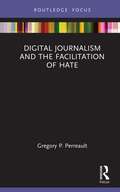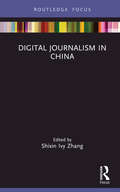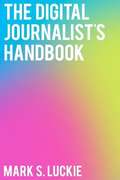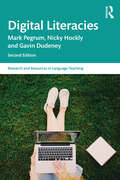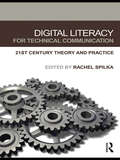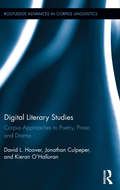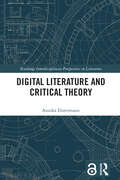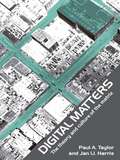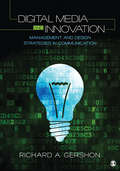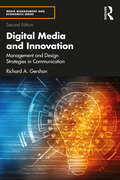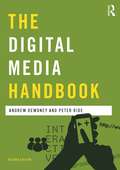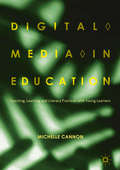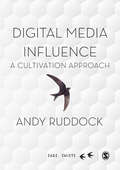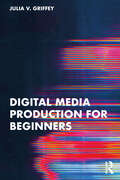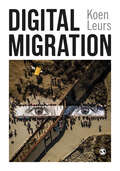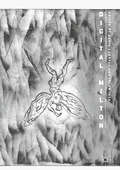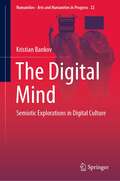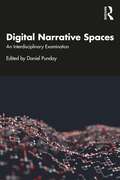- Table View
- List View
Digital Journalism and the Facilitation of Hate (Disruptions)
by Gregory P. PerreaultDigital Journalism and the Facilitation of Hate explores the process by which digital journalists manage the coverage of hate speech and "hate groups," and considers how digital journalists can best avoid having their work used to lend legitimacy to hate. Leaning on more than 200 interviews with digital journalists over the past three years, this book first lays the foundation by discussing the essential values held by digital journalists, including how they define journalism; what values they consider essential to the field; and how they practice their trade. Perreault considers the problem of defining "hate" and "hate groups" by the media, acknowledging journalism’s role in perpetuating hate through its continued ideological coverage of marginalized groups. Case studies, including the January 6 U.S. Capitol siege, the GamerGate controversy, and the Unite the Right rally in Charlottesville, help to elaborate on this problem and illustrate potential solutions. Digital Journalism and the Facilitation of Hate draws attention to the tactics of white nationalists in leveraging digital journalism and suggests ways in which digital journalists can more effectively manage their reporting on hate. Offering a valuable, empirical insight into the relationship between digital journalism and hate, this book will be of interest to students, scholars, and professionals of social and digital media, sociology, and journalism.
Digital Journalism in China (Disruptions)
by Shixin Ivy ZhangThis edited collection brings together journalism scholars from mainland China, Hong Kong, the UK and Australia to address a variety of pressing issues and challenges facing digital journalism in China today. While China shares certain affinities with the digital disruption of media in other settings, its experience and articulation of change is ultimately unique. This volume explores the implications of digital media technologies for journalists’ professional practice, news users’ consumption and engagement with news, as well as the shifting institutional, organizational and financial structures of news media. Drawing on case studies and quantitative and qualitative approaches, contributors address questions concerning: whether China is witnessing ‘disruptive’ or ‘sustainable’ journalism; if, and in what ways, digital technologies may disrupt journalism; and whether Chinese digital journalism converges with or diverges from Western experiences of digital journalism. Digital Journalism in China is an important addition to the literature on digital journalism, comparative media analysis, the Chinese Communist Party’s social media strategies, tabloidization trends, and the conflict between newsroom and classroom in journalism education, and will be of interest to advanced students, scholars, and practitioners alike.
The Digital Journalist's Handbook
by Mark S. LuckieThe Digital Journalist's Handbook is your guide to the tools you need to know to thrive in today's digital newsroom. This unique how-to book provides simple explanations of complex technologies and provides examples of how journalists can incorporate them into their stories and reporting. The Handbook is composed of 12 chapters, each dedicated to a different tool in the digital journalist's toolbox. Chapters include "Writing for the Web," "Blogging," "Photography," "Audio," "Audio Slideshows," "Video," "Web Design," "Social Networking," "Data Visualization," and "Flash," as well as a glossary with definitions of more than 130 technical terms and phrases commonly used in digital journalism. The Handbook is also fully illustrated and contains diagrams and guidelines of everything from the layout of a typical blog to the features found on a digital audio recorder. In addition, each chapter includes links to online resources, tutorials, and examples of every technology mentioned in the book. The Digital Journalist's Handbook is a must-read for both novice digital journalists and tech-savvy experts.
Digital Literacies (Literacies)
by Julia GillenWith our increasing use of digital and online media, the way we interact with these forms of communication is having an enormous impact on our literacy and learning. In Digital Literacies, Julia Gillen argues that to a substantial extent Linguistics has failed to rise to the opportunities presented by studying language in digital contexts. Assuming no existing knowledge, and drawing from a wide range of research projects, she presents a range of approaches to the study of writing and reading language online. Challenging some of the existing concepts, Digital Literacies traces key ideas through both the history of literacy studies and contemporary approaches to language online, including linguistic ethnography and corpus linguistics. Examples, taken from real life studies, include the use of digital technologies in everyday life, online teenage communities and professional use of Twitter in journalism. Within each chapter, the relevant research methods used are explored and then tied to the theory underpinning them. This book is an innovative and essential read for all those studying and researching applied linguistics, particularly in the areas of literacy and multimodality, at an upper undergraduate and postgraduate level. The title will also be of interest to those working with new media in the fields of Media and Communication Studies, Cultural Psychology, and Education.
Digital Literacies (Research and Resources in Language Teaching)
by Mark Pegrum Nicky Hockly Gavin DudeneyDramatic shifts in our communication landscape have made it crucial for language teaching to go beyond print literacy and encompass the digital literacies which are increasingly central to learners' personal, social, educational and professional lives. By situating these digital literacies within a clear theoretical framework, this book provides educators and students alike with not just the background for a deeper understanding of these key 21st-century skills, but also the rationale for integrating these skills into classroom practice. This is the first methodology book to address not just why but also how to teach digital literacies in the English language classroom. This book provides: A theoretical framework through which to categorise and prioritise digital literacies Practical classroom activities to help learners and teachers develop digital literacies in tandem with key language skills A thorough analysis of the pedagogical implications of developing digital literacies in teaching practice A consideration of exactly how to integrate digital literacies into the English language syllabus Suggestions for teachers on how to continue their own professional development through PLNs (Personal Learning Networks), and how to access teacher development opportunities online. This book is ideal for English language teachers, English language learners of all ages and levels, academics and researchers of all age groups and levels, academics and students researching digital literacies, and anyone looking to expand their understanding of digital literacies within a teaching framework.
Digital Literacies (Research and Resources in Language Teaching)
by Mark Pegrum Nicky Hockly Gavin DudeneyDramatic shifts in our communication landscape have made it crucial for language teaching to go beyond print literacy and encompass the digital literacies which are increasingly central to learners' personal, social, educational and professional lives. By situating these digital literacies within a clear theoretical framework, this book provides educators and students alike with not just the background for a deeper understanding of these key 21st-century skills, but also the rationale for integrating these skills into classroom practice. This is the first methodology book to address not just why but also how to teach digital literacies in the English language classroom. This book provides: A theoretical framework through which to categorise and prioritise digital literacies Practical classroom activities to help learners and teachers develop digital literacies in tandem with key language skills A thorough analysis of the pedagogical implications of developing digital literacies in teaching practice A consideration of exactly how to integrate digital literacies into the English language syllabus Suggestions for teachers on how to continue their own professional development through PLNs (Personal Learning Networks), and how to access teacher development opportunities online This book is ideal for English language teachers and learners of all age groups and levels, academics and students researching digital literacies, and anyone looking to expand their understanding of digital literacies within a teaching framework.
Digital Literacy for Technical Communication: 21st Century Theory and Practice
by Rachel SpilkaDigital Literacy for Technical Communication helps technical communicators make better sense of technology’s impact on their work, so they can identify new ways to adapt, adjust, and evolve, fulfilling their own professional potential. This collection is comprised of three sections, each designed to explore answers to these questions: How has technical communication work changed in response to the current (digital) writing environment? What is important, foundational knowledge in our field that all technical communicators need to learn? How can we revise past theories or develop new ones to better understand how technology has transformed our work? Bringing together highly-regarded specialists in digital literacy, this anthology will serve as an indispensible resource for scholars, students, and practitioners. It illuminates technology’s impact on their work and prepares them to respond to the constant changes and challenges in the new digital universe.
The Digital Literary Sphere: Reading, Writing, and Selling Books in the Internet Era
by Simone MurrayHow has the Internet changed literary culture?2nd Place, N. Katherine Hayles Award for Criticism of Electronic Literature by The Electronic Literature OrganizationReports of the book’s death have been greatly exaggerated. Books are flourishing in the Internet era—widely discussed and reviewed in online readers’ forums and publicized through book trailers and author blog tours. But over the past twenty-five years, digital media platforms have undeniably transformed book culture. Since Amazon’s founding in 1994, the whole way in which books are created, marketed, publicized, sold, reviewed, showcased, consumed, and commented upon has changed dramatically. The digital literary sphere is no mere appendage to the world of print—it is where literary reputations are made, movements are born, and readers passionately engage with their favorite works and authors.In The Digital Literary Sphere, Simone Murray considers the contemporary book world from multiple viewpoints. By examining reader engagement with the online personas of Margaret Atwood, John Green, Gary Shteyngart, David Foster Wallace, Karl Ove Knausgaard, and even Jonathan Franzen, among others, Murray reveals the dynamic interrelationship of print and digital technologies. Drawing on approaches from literary studies, media and cultural studies, book history, cultural policy, and the digital humanities, this book asks: What is the significance of authors communicating directly to readers via social media? How does digital media reframe the "live" author-reader encounter? And does the growing army of reader-reviewers signal an overdue democratizing of literary culture or the atomizing of cultural authority? In exploring these questions, The Digital Literary Sphere takes stock of epochal changes in the book industry while probing books’ and digital media’s complex contemporary coexistence.
Digital Literary Studies: Corpus Approaches to Poetry, Prose, and Drama (Routledge Advances in Corpus Linguistics)
by Jonathan Culpeper Kieran O'Halloran David L. HooverDigital Literary Studies presents a broad and varied picture of the promise and potential of methods and approaches that are crucially dependent upon the digital nature of the literary texts it studies and the texts and collections of texts with which they are compared. It focuses on style, diction, characterization, and interpretation of single works and across larger groups of texts, using both huge natural language corpora and smaller, more specialized collections of texts created for specific tasks, and applies statistical techniques used in the narrower confines of authorship attribution to broader stylistic questions. It addresses important issues in each of the three major literary genres, and intentionally applies different techniques and concepts to poetry, prose, and drama. It aims to present a provocative and suggestive sample intended to encourage the application of these and other methods to literary studies. Hoover, Culpeper, and O’Halloran push the methods, techniques, and concepts in new directions, apply them to new groups of texts or to new questions, modify their nature or method of application, and combine them in innovative ways.
Digital Literature and Critical Theory (Routledge Interdisciplinary Perspectives on Literature)
by Annika ElstermannThe aim at the core of this book is a synthesis of increasingly popular and culturally significant forms of digital literature on the one hand, and established literary and critical theory on the other: reading digital texts through the lens of canonical theory, but also reading this more traditional theory through the lens of digital texts and related media. In a field which has often regarded the digital as apart from traditional literature and theory, this book highlights continuities in order to analyse digital literature as part of a longer literary tradition. Using examples from social media to video games and works particularly by postmodern and poststructuralist theorists, Digital Literature and Critical Theory contextualises digital forms among their analogue precursors and traces ongoing social developments which find expression in these cultural phenomena, including power dynamics between authors and readers, the individual in (post-)modernity, consumerism, and the potential for intersubjective exchange.
Digital Matters: The Theory and Culture of the Matrix
by Jan Harris Paul TaylorAnalyzing the complex interaction between the material and immaterial aspects of new digital technologies, this book draws upon a mix of theoretical approaches (including sociology, media theory, cultural studies and technological philosophy), to suggest that the ‘Matrix’ of science fiction and Hollywood is simply an extreme example of how contemporary technological society enframes and conditions its citizens. Arranged in two parts, the book covers: theorizing the Im/Material Matrix living in the Digital Matrix. Providing a novel perspective on on-going digital developments by using both the work of current thinkers and that of past theorists not normally associated with digital issues, it gives a fresh insight into the roots and causes of the social matrix behind the digital one of popular imagination. The authors highlight the way we should be concerned by the power of the digital to undermine physical reality, but also explore the potential the digital has for alternative, empowering social uses. The book’s central point is to impress upon the reader that the digital does indeed matter. It includes a pessimistic interpretation of technological change, and adds a substantial historical perspective to the often excessively topical focus of much existing cyberstudies literature making it an important volume for students and researchers in this field.
Digital Media and Innovation: Management and Design Strategies in Communication
by Dr Richard A. GershonDigital Media and Innovation, by Richard A. Gershon, takes an in-depth look at how smart, creative companies have transformed the business of media and telecommunications by introducing unique and original products and services. Today's media managers are faced with the same basic question: what are the best methods for staying competitive over time? In one word: innovation. From electronic commerce (Amazon, Google) to music and video streaming (Apple, Pandora, and Netflix), digital media has transformed the business of retail selling and personal lifestyle. This text will introduce current and future media industry professionals to the people, companies, and strategies that have proven to be real game changers by offering the marketplace a unique value proposition for the consumer.
Digital Media and Innovation: Management and Design Strategies in Communication
by Dr Richard A. GershonDigital Media and Innovation, by Richard A. Gershon, takes an in-depth look at how smart, creative companies have transformed the business of media and telecommunications by introducing unique and original products and services. Today's media managers are faced with the same basic question: what are the best methods for staying competitive over time? In one word: innovation. From electronic commerce (Amazon, Google) to music and video streaming (Apple, Pandora, and Netflix), digital media has transformed the business of retail selling and personal lifestyle. This text will introduce current and future media industry professionals to the people, companies, and strategies that have proven to be real game changers by offering the marketplace a unique value proposition for the consumer.
Digital Media and Innovation: Management and Design Strategies in Communication (Media Management and Economics Series)
by Richard A. GershonThis fully updated second edition explores the importance of innovation and innovative thinking for the long-term success of today’s leading media, telecommunications, and information technology companies.The book takes an in-depth look at how smart, creative companies have transformed today's digital economy by introducing unique and highly differentiated products and services. This edition provides a detailed overview of intelligent networks and analyzes disruptive business models and processes from companies involved in social media, artificial intelligence, the metaverse, smart cities, and robotics among other emerging areas. From Apple to Zoom, this book considers some of the key people, companies, and strategies that have transformed the communication industries. Exploring the power of good ideas, this book goes inside the creative edge and looks at what makes such companies successful over time.Digital Media and Innovation is suited to advanced undergraduate and graduate courses in media management, media industries, communication technology, and business management and innovation, and provides up-to-date research for media and business professionals.
Digital Media and Risk Culture in China’s Financial Markets (Routledge Research in Digital Media and Culture in Asia)
by Zhifei MaoThis book analyzes the risk cultures in China that have emerged from the entanglement of new communication technologies and financial markets, examining the role that digital media play in Asian modernity and offering an alternative narrative to that of the West. The book illustrates the impact of exclusively Chinese digital media on power dynamics within risk definition, arguing that information and communication technologies (ICTs) empower individuals, enabling them to compete with an expert-oriented risk culture controlled by Government- and banker-led media outlets. With struggles, competitions, compromises, and confrontations, major communicators in financial world are collectively producing risk cultures based on interpersonal relations instead of contractual obligations, in which insider information is valued over professional analysis. Meanwhile, investors are trapped in a risk culture paradox that they themselves have produced, as they attempt to take advantage of other actors’ uncertainties and eventually produce risks for the entire market.
The Digital Media Handbook (Media Practice)
by Andrew Dewdney Peter RideThe new edition of The Digital Media Handbook presents an essential guide to the historical and theoretical development of digital media, emphasising cultural continuity alongside technological change, and highlighting the emergence of new forms of communication in contemporary networked culture. Andrew Dewdney and Peter Ride present detailed critical commentary and descriptive historical accounts, as well as a series of interviews from a range of digital media practitioners, including producers, developers, curators and artists. The Digital Media Handbook highlights key concerns of today’s practitioners, analysing how they develop projects, interact and solve problems within the context of networked communication. The Digital Media Handbook includes: Essays on the history and theory of digital media Essays on contemporary issues and debates Interviews with digital media professionals A glossary of technical acronyms and key terms.
Digital Media in Education: Teaching, Learning and Literacy Practices with Young Learners
by Michelle CannonThis book argues for dynamic and relevant school experiences for primary and early secondary learners that embed digital media production. It proposes a vision of literacy that combines new technologies with multiple modes of meaning-making. Drawing on theories related to cultural studies, media literacy, anthropology, and creativity, the author explores learning strategies with digital media based on an empowering, values-driven framework. The book advances innovative teaching methods, critiquing educational ‘reforms’ that marginalise media and fail to engage with the complex tensions and textures of modern pedagogy. Positioning film and media-making as vital practices in schools that nurture the skills, dispositions and competencies of modern literacy, the model foregrounds connections between human agency, cognition, and creative practice. This innovative book will appeal to students and scholars of creativity, digital media production, primary education and literacy.
Digital Media Influence: A Cultivation Approach (SAGE Swifts)
by Dr. Andy RuddockPopulism, misogyny, rampage murders. Digital media seem to lie at the heart of sinister, intractable social challenges. Curiously, the very societies who fear such things are often dismissive of media research. Addressing key issues affecting global media industries, this book explains how to solve the present conundrum by appreciating the historical development of cultivation theory. Digital Media Influence ties cultivation themes, such as mean world syndrome, mainstreaming, the celebration of white male violence, the ridiculing of ageing women, the inhibition of activism, the mediatisation of religion and the erosion of trust in education, with contemporary digital media case studies. Considering the aftermath of the Parkland murders, political memes, Islamophobia, the fate of female reality TV stars and the bad press directed at media education, Ruddock shows how these phenomena are born of media practices that cultivation theory began to dissect in the 1950s. Paying close attention to the life and work of George Gerbner, Digital Media Influence locates today&’s questions in the historical forces and relationships that moved media industries closer to the heart of global politics in the mid-20th century. It makes Gerbner&’s work relevant to all critical media researchers by providing a theoretical, methodological and historical steer for understanding new media influences. In explaining how one of the world&’s leading media theories developed in relation to intriguing historical circumstances – many of them deeply personal – this book helps researchers of all levels to find their voice in writing on media issues.
Digital Media Influence: A Cultivation Approach (SAGE Swifts)
by Dr. Andy RuddockPopulism, misogyny, rampage murders. Digital media seem to lie at the heart of sinister, intractable social challenges. Curiously, the very societies who fear such things are often dismissive of media research. Addressing key issues affecting global media industries, this book explains how to solve the present conundrum by appreciating the historical development of cultivation theory. Digital Media Influence ties cultivation themes, such as mean world syndrome, mainstreaming, the celebration of white male violence, the ridiculing of ageing women, the inhibition of activism, the mediatisation of religion and the erosion of trust in education, with contemporary digital media case studies. Considering the aftermath of the Parkland murders, political memes, Islamophobia, the fate of female reality TV stars and the bad press directed at media education, Ruddock shows how these phenomena are born of media practices that cultivation theory began to dissect in the 1950s. Paying close attention to the life and work of George Gerbner, Digital Media Influence locates today&’s questions in the historical forces and relationships that moved media industries closer to the heart of global politics in the mid-20th century. It makes Gerbner&’s work relevant to all critical media researchers by providing a theoretical, methodological and historical steer for understanding new media influences. In explaining how one of the world&’s leading media theories developed in relation to intriguing historical circumstances – many of them deeply personal – this book helps researchers of all levels to find their voice in writing on media issues.
Digital Media Production for Beginners
by Julia V. GriffeyWritten for the non-specialist media producer, this book offers a practical and engaging guide to basic digital media production using modern equipment and software.As media production tools and software become more pervasive and traditional media jobs scarcer, today’s media professionals are now expected to be content creators across multiple forms of media, often working with little more equipment than a smartphone. In this accessible manual, Griffey explains how well-crafted media can help sell products, bolster subscriptions, and influence public opinion—and how to go about crafting it in a landscape of high-speed social media consumption. Topics covered include the basics of photography, film, video, and audio production, as well as animation and building websites. Readers will learn not just how to shoot or record content, but also how to edit, compress, and share it, considering the most appropriate file types, equipment, software, and platforms to use for each scenario. After reading this book, students will understand best practices associated with almost every area of media production and possess the essential skills to get the job done.This book is an essential companion for students in communication disciplines, including PR, advertising, journalism, and marketing, looking for a solid grounding in digital media production to prepare them for the competitive job market.
Digital Migration
by Koen Leurs"A revelation for digital researchers and a provocation for migration scholars… It introduces an insightful, inspiring, and inviting way of making sense of the messiness without losing hope of changing things." - Nishant Shah, Chinese University of Hong Kong "A must read for everyone who is concerned with questions of human mobility, media and communications and the digital border." - Myria Georgiou, LSE "A much-needed addition to scholarship on mobility, technology, and migration… The book is poised to become a touchstone text." - C.L. Quinan University of Melbourne In contemporary discussions on migration, digital technology is often seen as a ′smart′ disruptive tool. Bringing efficiencies to management, and safety to migrants. But the reality is always more complex. This book is a comprehensive and impassioned account of the relationship between digital technology and migration. From ′top-down′ governmental and corporate shaping of the migrant condition, to the ′bottom-up′ of digital practices helping migrants connect, engage and resist. Taking an interdisciplinary approach, Digital Migration explores: The power relations of digital infrastructures across migrant recruitment, transportation and communication. Migrant connections and the use of digital devices, platforms and networks. Dominant digital representations of migrants, and how they’re resisted. The affect and emotion of digital migration, from digital intimacy to transnational family life. How histories of pre and early-digital migration help us situate and rethink contemporary research. The realities of researching digital migration, including interviews with leading international researchers. Critical yet hopeful, Koen Leurs opens up the unequal power relations at the heart of digital migration studies, challenging us to imagine more just alternatives. Koen Leurs is an Associate Professor in Gender, Media and Migration Studies at the Graduate Gender Program, Department of Media and Culture, Utrecht University, the Netherlands. All author royalties for this book will be donated to the Alarm Phone, a hotline for boatpeople in distress.
Digital Migration
by Koen Leurs"A revelation for digital researchers and a provocation for migration scholars… It introduces an insightful, inspiring, and inviting way of making sense of the messiness without losing hope of changing things." - Nishant Shah, Chinese University of Hong Kong "A must read for everyone who is concerned with questions of human mobility, media and communications and the digital border." - Myria Georgiou, LSE "A much-needed addition to scholarship on mobility, technology, and migration… The book is poised to become a touchstone text." - C.L. Quinan University of Melbourne In contemporary discussions on migration, digital technology is often seen as a ′smart′ disruptive tool. Bringing efficiencies to management, and safety to migrants. But the reality is always more complex. This book is a comprehensive and impassioned account of the relationship between digital technology and migration. From ′top-down′ governmental and corporate shaping of the migrant condition, to the ′bottom-up′ of digital practices helping migrants connect, engage and resist. Taking an interdisciplinary approach, Digital Migration explores: The power relations of digital infrastructures across migrant recruitment, transportation and communication. Migrant connections and the use of digital devices, platforms and networks. Dominant digital representations of migrants, and how they’re resisted. The affect and emotion of digital migration, from digital intimacy to transnational family life. How histories of pre and early-digital migration help us situate and rethink contemporary research. The realities of researching digital migration, including interviews with leading international researchers. Critical yet hopeful, Koen Leurs opens up the unequal power relations at the heart of digital migration studies, challenging us to imagine more just alternatives. Koen Leurs is an Associate Professor in Gender, Media and Migration Studies at the Graduate Gender Program, Department of Media and Culture, Utrecht University, the Netherlands. All author royalties for this book will be donated to the Alarm Phone, a hotline for boatpeople in distress.
Digital Milton
by Islam Issa David CurrellDigital Milton is the first volume to investigate John Milton in terms of our digital present. It explores the digital environments Milton now inhabits as well as the diverse digital methods that inform how we read, teach, edit, and analyze his works. Some chapters use innovative techniques, such as processing metadata from vast archives of early modern prose, coding Milton’s geographical references on maps, and visualizing debt networks from literature and from life. Other chapters discuss the technologies and platforms shaping how literature reaches us today, from audiobooks to eReaders, from the OED Online to Wikipedia, and from Twitter to YouTube. Digital Milton is the first say on a topic that will become ever more important to scholars, students, and teachers of early modern literature in the years to come.
The Digital Mind: Semiotic Explorations in Digital Culture (Numanities - Arts and Humanities in Progress #22)
by Kristian BankovThis book reveals the core features of digital culture, examined by means of semiotic models and theories. It positions commercial and market principles in the center of the digital semiosphere, avoiding the need to force the new cultural reality into the established textualist or pragmatist paradigms. The theoretic insights and case studies presented here argue for new semiotic models of inquiry that include working with big data, user experience and nethnography, along with conventional approaches.The book develops a new concept of identity in the digital age, analyzing the digital flows of recognition and value, which led to the tremendous success of Social Media and the Web 2.0 era. Self-expression, entertainment and consumerism are seen as the major drivers of identity formation in the post-truth era, where the self can no longer be considered independently of a given person’s communication devices, where a substantial part of it is stored and actualized. It will be of interest to semioticians and researchers working on digital culture.
Digital Narrative Spaces: An Interdisciplinary Examination
by Daniel PundayThere is a broad consensus that digital narrative is "spatial," but what this critical term means and how it is used varies greatly depending on the discipline from which it is approached. Digital Narrative Spaces brings together essays by prominent scholars in electronic literature and other forms of digital authorship to explore the relationship between story and space across these disciplines. This volume includes an introduction with Marie-Laure Ryan’s typology of space, followed by thought-provoking individual chapters which explore innovative explorations of electronic literature, locative media, literary tourism, and the mapping of real-world literary spaces. The collection closes with an essay analyzing continuities and discontinuities in theory of space across the chapters. This volume will provide an important framework for establishing a dialogue across disciplines and future scholarship in these fields.
